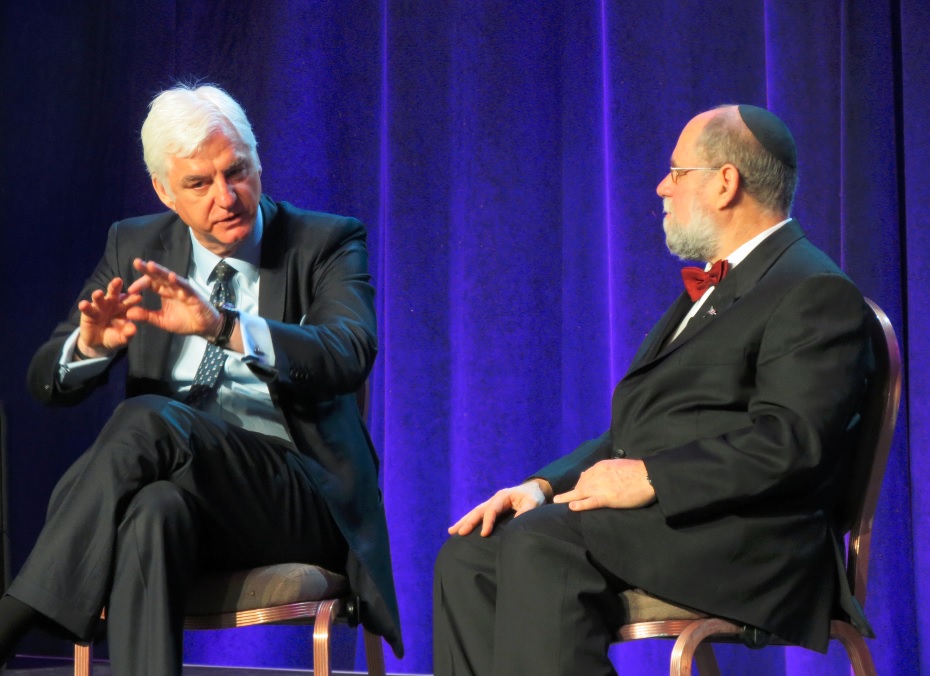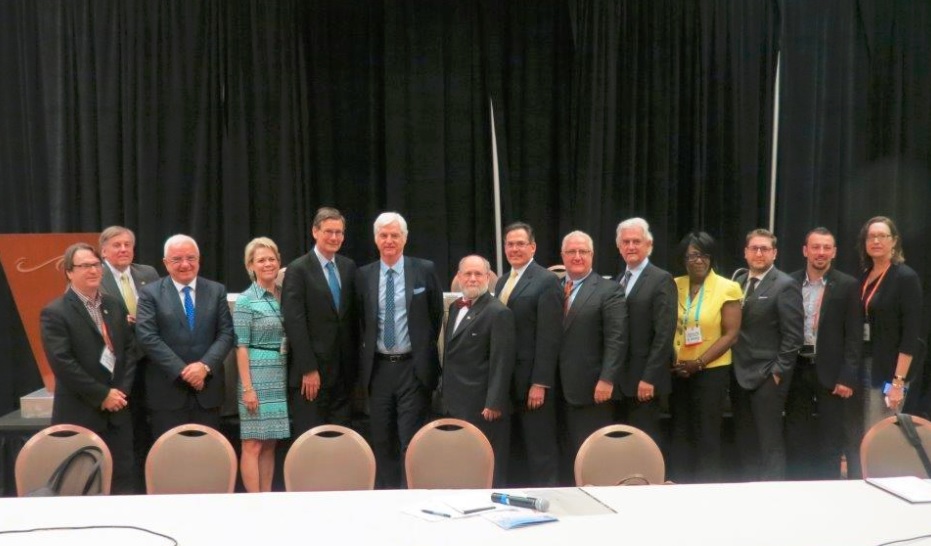|
RAPAPORT... “All value in the diamond business emanates from the consumer desire for our product. Without that consumer desire, there would be no investment in exploration, there would be no investment in new mines, no one would build any stores, and none of us would have anything to do because there would be no one willing to pay for it.” - Stephen Lussier, CEO of De Beers Forevermark, at the annual Rapaport Breakfast in Las Vegas, May 31, 2015.
One might differentiate between consumer desire and confidence but there is no doubt that they are the deepest concerns in the diamond industry today. While the diamond dream still needs to be sold to millennials, that new generation of consumers is demanding assurances about the diamond product.
These two themes were the focus of various Rapaport conferences that took place during the JCK Las Vegas show.
The desire for diamonds is largely dependent upon confidence in the product. While Lussier’s game plan to keep the diamond dream alive focused on fueling desire for diamonds, the discussions that followed later in the day were especially motivated by a need to drive confidence.
Martin Rapaport’s annual “State of the Diamond Industry” address, and the respective Rapaport Diamond Grading and Responsible Sourcing Conferences, focused on similar themes to Lussier’s presentation: What’s being done to ensure consumer confidence in the diamond product?
 Lussier (pictured left with Martin Rapaport) urged the industry not to take the “diamond dream” for granted. If that dream encompasses the product being a universal symbol of love, an elegant symbol of success, that it is timeless and has enduring value, he stressed that the new generation of millennial consumers need to be taught that dream.
Lussier outlined four areas for the industry to instill that dream in the psyche of millennials, as it has been with previous generations. The industry needs to:
1. Defend the core symbolism of diamonds, 2. Engage in the debate between timeless and disposable fashion, 3. Win in the digital space, and 4. Fight for the integrity of the industry.
To achieve all that, Lussier stressed that there needs to be greater investment in diamond brands – ultimately, “brands don’t sell products, they sell dreams.” He insisted that the industry needs to dramatically improve the quality of retail and marketing content, the midstream should work with its retail clients to create better margins and participate in telling the diamond story, and have diamond producers tell that story as well.
Martin Rapaport, chairman of the Rapaport Group, endorsed Lussier’s philosophy to sell the idea behind the product, rather than the product itself, and he called on the mining companies to invest about 5 percent of their revenue in such marketing activities. After all, the millennials have certainly not grown up with the type of generic diamond marketing campaigns that created the diamond dream in the first place.
However, Rapaport also outlined serious concerns affecting the trade’s ability to invest in such programs. Notably, the lack of profitability is restraining the manufacturing sector’s participation in marketing. Rapaport insisted that the industry must address the reason why rough prices are too high relative to polished and called on the banks in India to cut back on giving credit for rough purchases.
While the lack of profitability has affected dealer and manufacturer confidence, other trade-related issues have already filtered to the consumer level. It has become more important than ever for retailers to be able to verify their product. Rapaport stressed that the industry must maintain a level-playing field so that cheaters are marginalized, whether they’re engaged in over-grading diamonds, money laundering, bribing or mixing undisclosed synthetics with natural diamonds.
In that spirt, the Rapaport Diamond Grading Conference questioned whether the industry can enforce a single grading standard, especially in light of recent examples of laboratories over-grading diamonds. The majority of attendees endorsed the use of Gemological Institute of America (GIA) standards as the norm.
Susan Jacques, GIA’s CEO (pictured, courtesy GIA) noted that anyone who wishes to grade according to GIA standards has the ability to do so. However, she stressed that by using the GIA terminology and scales of color and clarity, together with cut, one should use the same grading parameters as the GIA. “Consumer confidence would expect us to compare apples to apples and not to oranges, so if you use our terminology, you apply our standards,” Jacques added.
Cecilia Gardner, CEO and legal counsel of the Jewelers Vigilance Committee (JVC), which is the legal arm of the U.S. jewelry and gem trade, stated that the JVC views the GIA letter-grading terminology as an accepted trade practice in the industry. Accordingly, representatives from the International Gemological Institute (IGI), Gemological Science International (GSI) and the American Gem Society (AGS) each said that they use GIA standards in their respective grading.
The one exception on the panel was HRD Antwerp which, as a European lab, uses standards and a scale developed by the International Diamond Council (IDC), under the auspices of the World Federation of Diamond Bourses (WFDB) and the International Diamond Manufacturers Association (IDMA).
Gardner warned that a large proportion of complaints received by the JVC involve grading reports whereby there has been a deception in the true quality of the diamond. “These cases inevitably result in fueling a negative consumer attitude toward the industry, regardless of the end result,” she stressed.
Similarly, the Rapaport Responsible Sourcing Conference (panelists pictured below) cautioned that the industry has a reputational risk in its sourcing practices and debated what jewelers can do to ensure the legitimacy of the products they sell.
 David Bouffard, vice president of corporate affairs at Signet Jewelers, explained that his company uses a two-pronged approach in its sourcing by looking at the product it is dealing with and the suppliers with which it is working.
He stressed that the Responsible Jewellery Council (RJC) is central to Signet’s responsible sourcing strategy. Some in the audience challenged whether the RJC is in fact an appropriate standard for diamonds given that it has only a code of practices for the category, unlike its robust chain-of-custody standards for gold and platinum. In fact, the question was raised as to whether responsible sourcing can be applied across the diamond industry supply chain as a whole.
Following from his morning session, Rapaport continued his support of the RJC as a good base from which to develop responsible sourcing standards, and called for the creation of auditable chain-of-custody standards for diamonds. Rapaport stressed that the industry needs to separate good suppliers from bad and that suppliers need to be held accountable for what they sell. That would take into account responsible sourcing, ensuring that the quality of the diamond meets acceptable and fair grading standards and that the diamonds are natural as disclosed. He suggested that companies should use hallmarks to guarantee the quality and source of the diamond.
Hallmarked products from certified companies can provide a unique selling proposition that attracts premium prices and help companies add value, Rapaport explained. He predicted that demand for products that have this kind of certification, or hallmarking, will increase in the future.
After all, the Rapaport conferences signaled that the trade is in a state of extreme uncertainty, and is looking for solutions to sustain, or perhaps restore, consumer confidence. The more each player along the distribution chain can ethically vouch for its product, the more likely that the diamond dream can and will be taught to millennials.
As Lussier urged in his final thought for diamantaires and jewelers at the Rapaport Breakfast: “With every decision you make, you should ask yourself if that decision is going to make this woman proud to have that diamond on her finger for the rest of her life,” he said. “If you do anything that would not make her proud of that diamond, don't do it. That's the biggest risk to the dream and that's the easiest thing for all of us to get right.”
The writer can be contacted at avi@diamonds.net.
Follow Avi on Twitter: @AviKrawitz and on LinkedIn.
This article is an excerpt from a market report that is sent to Rapaport members on a weekly basis. To subscribe, go to www.diamonds.net/weeklyreport/ or contact your local Rapaport office.
Copyright © 2015 by Martin Rapaport. All rights reserved. Rapaport USA Inc., Suite 100 133 E. Warm Springs Rd., Las Vegas, Nevada, USA. +1.702.893.9400.
Disclaimer: This Editorial is provided solely for your personal reading pleasure. Nothing published by The Rapaport Group of Companies and contained in this report should be deemed to be considered personalized industry or market advice. Any investment or purchase decisions should only be made after obtaining expert advice. All opinions and estimates contained in this report constitute Rapaport`s considered judgment as of the date of this report, are subject to change without notice and are provided in good faith but without legal responsibility. Thank you for respecting our intellectual property rights. |